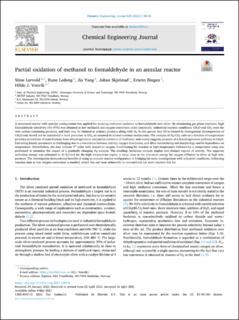| dc.contributor.author | Lervold, Stine | |
| dc.contributor.author | Lødeng, Rune | |
| dc.contributor.author | Yang, Jia | |
| dc.contributor.author | Skjelstad, Johan | |
| dc.contributor.author | Bingen, Kristin | |
| dc.contributor.author | Venvik, Hilde Johnsen | |
| dc.date.accessioned | 2022-03-01T09:00:53Z | |
| dc.date.available | 2022-03-01T09:00:53Z | |
| dc.date.created | 2021-06-09T21:11:55Z | |
| dc.date.issued | 2021 | |
| dc.identifier.citation | Chemical Engineering Journal. 2021, 423 . | en_US |
| dc.identifier.issn | 1385-8947 | |
| dc.identifier.uri | https://hdl.handle.net/11250/2981955 | |
| dc.description.abstract | A structured reactor with annular configuration was applied for studying methanol oxidation to formaldehyde over silver. By eliminating gas phase reactions, high formaldehyde selectivity (93–97%) was obtained at low methanol and oxygen conversion under practically isothermal reaction conditions. CH2O and CO2 were the only carbon containing products, and both may be claimed as primary products along with H2. It also proves that CO is formed by homogenous decomposition of CH2O and should not be considered a main precursor to CO2, as assumed in several reaction mechanisms. The analysis of H2/CO2 ratio as a function of temperature provides an estimate of contributions from dehydrogenation and partial oxidation of methanol, and clearly suggests presence of a dehydrogenation pathway to CH2O. Extracting kinetic parameters is challenging due to a correlation between activity, oxygen dissolution, and silver restructuring and morphology and its dependence on temperature. Nevertheless, the data indicate 1st order with respect to oxygen. Conditioning by reaction at high temperature followed by a temperature ramp was performed to minimize the impact of a gradually changing Ag catalyst. The resulting Arrhenius analysis implies two distinct regions of activity. The apparent activation energy was estimated to 41 kJ/mol for the high temperature region, a value close to the activation energy for oxygen diffusion in silver at high temperature. The investigation demonstrates benefits of using an annular reactor configuration in bridging lab scale investigations with industrial conditions. Collecting reaction data at low oxygen conversion is enabled, which has not been achievable in conventional lab scale reactors this far. | en_US |
| dc.language.iso | eng | en_US |
| dc.publisher | Elsevier | en_US |
| dc.rights | Attribution-NonCommercial-NoDerivatives 4.0 Internasjonal | * |
| dc.rights.uri | http://creativecommons.org/licenses/by-nc-nd/4.0/deed.no | * |
| dc.title | Partial oxidation of methanol to formaldehyde in an annular reactor | en_US |
| dc.type | Peer reviewed | en_US |
| dc.type | Journal article | en_US |
| dc.description.version | publishedVersion | en_US |
| dc.source.pagenumber | 11 | en_US |
| dc.source.volume | 423 | en_US |
| dc.source.journal | Chemical Engineering Journal | en_US |
| dc.identifier.doi | 10.1016/j.cej.2021.130141 | |
| dc.identifier.cristin | 1914934 | |
| dc.relation.project | Norges forskningsråd: 237922 | en_US |
| cristin.ispublished | true | |
| cristin.fulltext | original | |
| cristin.qualitycode | 2 | |

